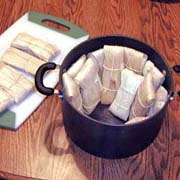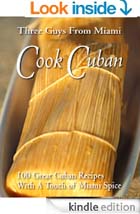Jorge Castillo: In Cuba they use a type of field (or dent) corn, it's not as sweet and it's more mealy than the sweet corn we eat in the U. S.
Glenn Lindgren: If you have a friendly farmer nearby, you may be able to buy some.
Raúl Musibay: But please note, you need fresh field corn, NOT the dried stuff they feed to the cattle! You'd have to find a farmer with a field who would let you pick it fresh off the stalk. In Cuba we cut off the corn kernels with a grooved piece of wood with a blade in it.
Glenn Lindgren: The easy way? Use sweet corn. The masa flour tends to dampen the sweetness.
Jorge Castillo: We've even used frozen Niblets corn when fresh corn on the cob wasn't available! The difference in taste is very slight.
Raúl Musibay: Most people (even Cubans) wouldn't know the difference!
Glenn Lindgren: Some beginners make the mistake of using pieces of meat that are too large. Good tamales are riddled with tiny flecks of meat.
Jorge Castillo: We made our tamales for the Travel Channel in 2005.
Glenn Lindgren: The show was "Taste of America" with Mark DeCarlo.
Cuban Tamales
By
Prep time: 30 minutesCook time: 1 hour 30 minutes
Total time: 2 hours
Yield: 12-16 tamales
Good Cuban tamales are not stuffed like a Mexican tamal; instead, they are riddled with tiny flecks of meat.
INGREDIENTS:
1 1/2 pounds pork in chunks2 cloves garlic, whole, peeled
1 tablespoon vinegar
water to cover meat
3 cups ground fresh yellow corn (may substitute frozen)
3/4 cup lard, butter, or shortening
2 1/2 cups masa harina
2 1/2 cups chicken broth
1/4 teaspoon bijol (annato seed powder)
1/4 cup olive oil for frying
1 large onion, chopped fine
1 large green pepper, chopped fine
5 cloves garlic, minced
3 ounces tomato paste (1/2 can)
1/2 cup water
1/2 cup wine (red or white)
1 large lemon (juice only)
1 teaspoon salt
1/2 teaspoon black pepper (fresh ground)
24-32 dried corn husks (Soak dried cornhusks in hot water before using)
For meat, you need pork with plenty of fat -- either well marbled or with a fat layer or both. We've had good luck with de-boned country style pork ribs. Or have the butcher cut something to order.
Whichever meat you use, cut it up into smaller pieces -- no more than two inches thick or three inches long. Add a little salt with a shaker and place in a large sauce pan. Add water to just barely cover the meat. Add two peeled garlic cloves and one tablespoon vinegar. Bring to a boil; reduce heat and simmer, uncovered until all of the water has boiled away. Fry the pork pieces in the rendered fat just until brown, but NOT crispy! The meat should be tender and stringy. Remove the meat. Trim off any excess fat (there shouldn't be any) and with a knife or meat hammer; break up the meat into small pieces.
Slice the corn kernels off the cob (or use frozen corn). Quickly grind the corn in a food processor with your choice of fat (lard, or butter, or shortening) until you get a very coarse mixture with visible corn kernels. Don't over process! Remove from the processor and blend in 2 1/2 cups warm chicken broth and two cups masa harina to the ground corn. Add a dash of Bijol powder to give it a nice yellow color.
Fry the onion and green pepper in olive oil at medium heat, stirring occasionally, until the onions are soft. Add garlic and continue to fry for two to three minutes. Do not drain off excess oil! Mix tomato paste in 1/2 cup warm water and add it and the wine to the vegetables. Simmer for about 10 minutes.
Place the pork, vegetables, and the ground corn/masa mixture in a large cooking pot. Add lemon juice to the mixture and blend. Add salt and pepper and stir. Cook the mixture on low heat, stirring frequently (don't let it burn!) until it thickens -- about 20 minutes.
Add more masa or more broth as necessary so that you have a stiff, but pliable paste. Taste and add salt if needed. Remove from heat and let cool.
OUR COOKBOOKS ARE NOW AVAILABLE AS KINDLE EBOOKS!
This new Kindle version contains all of the recipes and editorial copy from the original print edition. As a bonus, the new Kindle edition includes 14 new photos of the prepared dishes.
No Kindle?
Use the FREE Kindle Reading App and view our cookbooks on your notepad, tablet, laptop, or computer.
To make the tamales:
Take two corn husks and overlap them flat on the table. Put some of the corn mixture in the center of the cornhusks. Fold the cornhusks, first over the filling the short way, and then folding up the liong way from the ends. Tie with a string.
Tamales are best cooked in a large pot with about two inches of water in the bottom. (If you have the little insert that keeps the food off the bottom, great!) Add the tamales, standing them on end and cover the pot. Bring the water to a boil. Reduce heat and simmer/steam about 90 minutes to two hours.
IMPORTANT: Be sure to check the water level occasionally so that the pot doesn't run dry!
TIP:
Freshly cooked tamales tend to be a bit mushy.
The BEST way to make tamales is to cook them a day ahead and then put them in the refrigerator overnight.
Cooling will help the tamales firm up to the proper consistency. The next day, just steam them long enough to heat through. If you'd like to make a large batch and freeze them, always cook the tamales first and then freeze.
Usually we can't resist and end up eating a couple of "loose" tamales the same day we cook them!

Variation:
Ham Tamales
Use the same recipe above for pork; only substitute some finely chopped ham!
Don't fry the ham, but do blanch it in boiling water for a minute or two -- this will draw off any excess fat and reduce some of the hammy-ness. (If you have an excellent tasting premium ham, you can omit this step.).


Three Guys From Miami Show You How to Make the Best Cuban, Spanish, and Latin American Food!
Drinks | Appetizers | Salads | Main Dishes| Soups | Side Dishes | Desserts | Index

Visit All of Our Sites:
Three Guys From Miami:
Cuban, Spanish, and Latin American food recipes, Miami/Little Havana Travel Guide, Miami Restaurant Guide, Hispanic Culture & Food
The Three Guys From Miami are: Raúl Musibay, Glenn Lindgren, and Jorge Castillo
Check out The Three Guys From Miami's Google+ Fan Page
No copying or commercial duplication of any content (including photos) without the express written permission of the authors and proper attribution.





